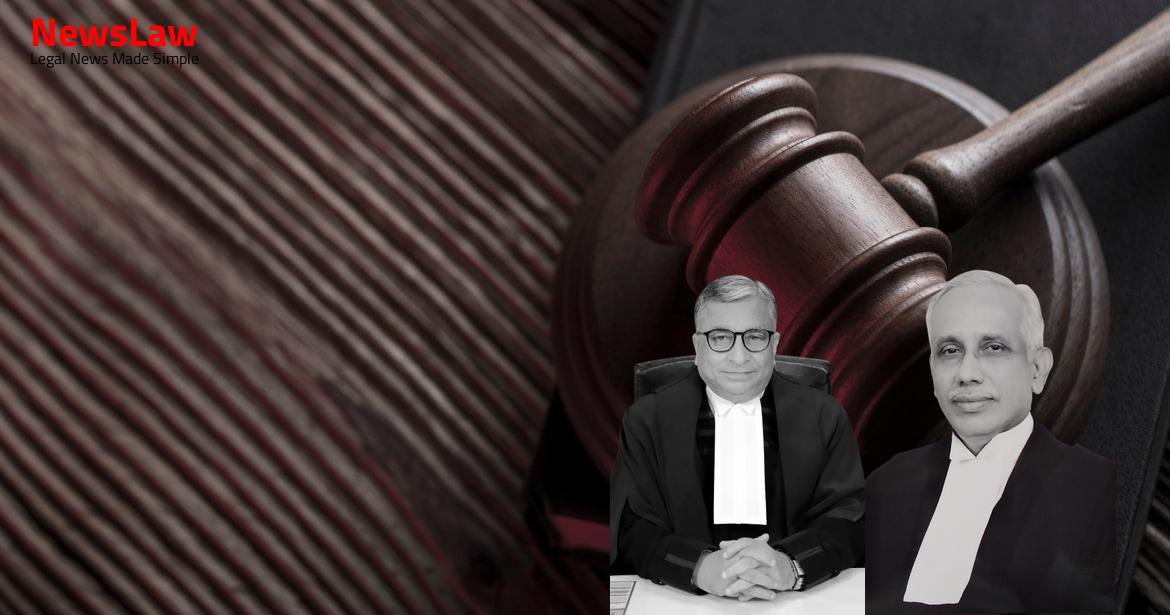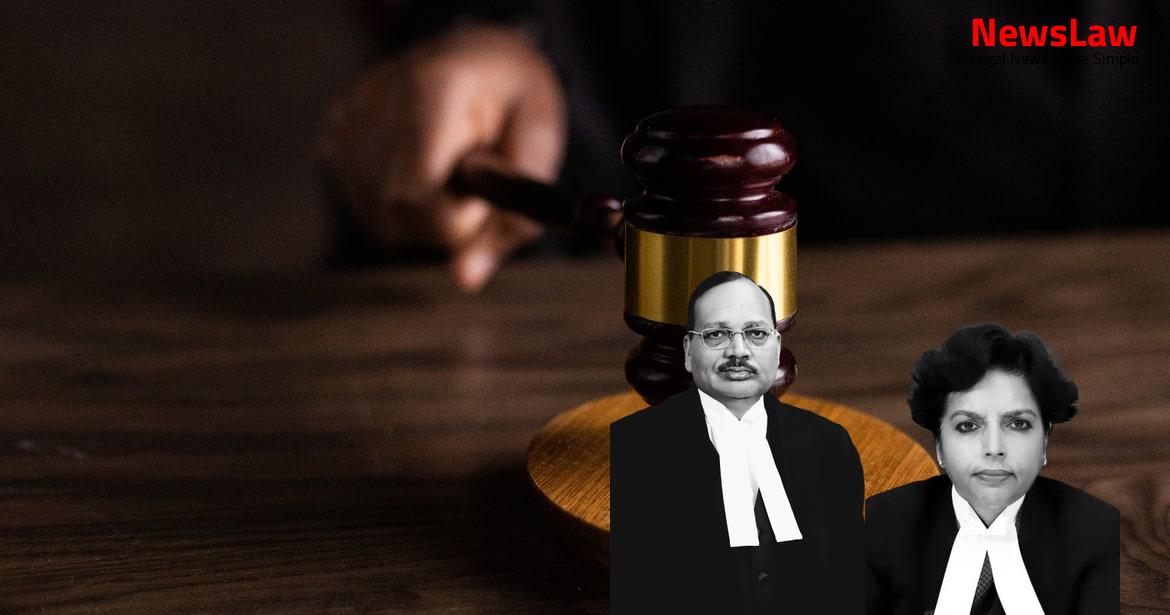The court’s legal analysis in a recent case sheds light on the crucial aspect of burden of proof in homicide cases. Understanding how the prosecution must meet its burden and how the accused can offer a defense under Section 106 of the Evidence Act is paramount. Dive into the intricate details of the court’s interpretation and application of legal principles in determining guilt beyond reasonable doubt.
Facts
- The deceased was found dead inside the kitchen of the house, initially suspected to have committed suicide by consuming poison.
- Post-mortem examination revealed death was caused by compression on the lower part of the neck, resulting in blockage of the upper end of the trachea.
- The deceased was identified as Sanjay Rana on 24.07.2008 by Ranjan Rana.
- The deceased was found to have been assaulted by two or more persons with acid and blunt objects.
- Accused appellants Sabitri Samantaray and Bidyadhar Praharaj were identified as wife and husband respectively.
- The landlord reported hearing a loud cry from the portion of the house rented to the appellants, and saw an unknown person assaulting them with a ‘Kata’.
- Accused appellants were tenants of Mayadhar Mohapana, and it was revealed that the deceased had a love relationship with their daughter.
- Accused appellants were convicted by the High Court for the homicide of the deceased.
- Accused appellants reportedly overpowered the deceased, who was unarmed, throttled him to death, and poured acid on him to impede identification.
- Charge sheet was submitted against the accused appellants and their daughter for offenses under Sections 302, 201, 109, and 34 IPC.
- Accused appellants claimed that the unknown person forcibly entered their house and locked it from inside, while their daughter had no role in the incident.
- The landlord intervened when the unknown person attacked the accused appellants, causing other people to gather and help rescue the couple.
- Conviction under Section 302 IPC modified to Section 304 (II) IPC
- Both accused sentenced to five years rigorous imprisonment
- High Court acquitted the daughter of the appellants due to absence at the scene of the offence
- Appellants convicted for offences under Sections 302, 201 read with Section 34 IPC
- Appellants sentenced to rigorous imprisonment for life and a fine of Rs. 10,000/-
- Daughter convicted under Sections 302, 109 read with Section 34 IPC and sentenced similarly
- High Court upheld conviction of appellants
- Observation that an assault resulted from a prior altercation between the appellants and the deceased
Also Read: Presumption of Marriage in Long-term Cohabitation Cases
Issue
- The key issue in the case is whether the prosecution has met the burden of proof.
- Determining if the chain of events has been established to apply Section 106 of the Evidence Act.
- Section 106 places the burden of proving things within special knowledge on the individual.
Also Read: Navigating Legal Challenges: Court’s Analysis on Limitation Act in IBC Proceedings
Arguments
- The judgment is in contravention to the law laid down by the court in Shambu Nath Mehra Vs. State of Ajmer, 1956 SCR 199 5 9.
- The High Court erred in convicting the appellants solely based on circumstantial evidence.
- Absence of eye-witness should have been considered by the High Court.
- The High Court overlooked the post-mortem report indicating the time of death of the deceased when the appellants were in the hospital due to injuries suffered from the deceased’s assault.
- The reliance on answers provided by the appellants under Section 313 of CrPC is misplaced as they are inadmissible as evidence.
- The reliance on Section 106 of the Evidence Act is misconstrued without clear evidence pointing to the guilt of the appellants accused.
- The prosecution failed to prove its case beyond reasonable doubt and did not discharge its burden of proof.
- The Respondent contends that the High Court correctly observed the involvement of the appellants based on admitted facts, evidence, relationships, telephonic contacts, and the presence of the appellants at the scene of the crime.
- The first set of witnesses did not provide a complete narration of events, while the second set established the relationship between the deceased and the appellants.
- It is argued that the appellants, being the only ones present at the scene, have special knowledge under Section 106 of the Evidence Act.
- The Trial Court upheld the reliance on Section 106 and the judgment in Rajendra Kumar Vs. State of Rajasthan.
- The contention that the prosecution did not rely on Section 106 is deemed incorrect, as the burden to establish a case is not solely on the prosecution, and the accused must offer an explanation.
- The medical expert’s deposition does not mention that the deceased died when the appellants were injured in the hospital.
Also Read: Legal Analysis on Tariff Determination and Discoms’ Obligations
Analysis
- The deceased intended to marry accused no. 3 but she started avoiding him after getting a job at a bank, leading to his frustrations.
- The accused appellants falsely claimed not to know the deceased, despite their daughter admitting he used to visit their house.
- The deceased gave Rs. 70,000 to accused no. 3 upon her request for help.
- The deceased, a jeweler, was in a love relationship with accused no. 3, visiting their house once or twice a month.
- The prosecution established a chain of events implicating the appellants beyond reasonable doubt.
- The appellants were responsible for strangulating the deceased and attempting to conceal his identity by pouring acid over his body.
- The burden of proof shifted to the appellants under Section 106 of the Evidence Act to explain the circumstances of the crime.
- Statements of witnesses provided a motive for the offense, and minor contradictions did not discredit the prosecution’s evidence.
- The deceased left the house stating he would return with accused no. 3 or retrieve his money, and his injuries were deemed homicidal.
- The appellants failed to provide a credible explanation for the death under Section 106 of the Evidence Act.
- The prosecution successfully proved the appellants’ intention to commit the offense through witness statements and medical evidence.
- In cases where murder is committed in secrecy inside a house, the burden of proof on the prosecution is comparatively lighter.
- The nature and amount of evidence required to establish a murder charge in such cases is not the same as in cases of circumstantial evidence.
- The prosecution must bring sufficient evidence pointing towards the guilt of the accused to meet the initial burden of proof.
- Last seen together is not conclusive proof but along with other circumstances can lead to a presumption of guilt.
- Accused has burden of proof under Section 106 of the Evidence Act when last seen together.
- Relations between accused and deceased, enmity, previous hostility, recovery of weapon, non-explanation of death, can contribute to presumption of guilt.
- Sequence of events in this case strongly point towards guilt of accused appellants.
- Accused failed to provide a credible defense.
- No error found in the judgment passed by the High Court.
Decision
- The bail bonds of the two accused have been cancelled.
- The accused are directed to surrender before the Trial Court within two weeks.
- If they fail to surrender, they will be taken into police custody.
- The appeals have been dismissed.
Case Title: SABITRI SAMANTARAY Vs. THE STATE OF ODISHA (2022 INSC 608)
Case Number: Crl.A. No.-000988-000988 / 2017



